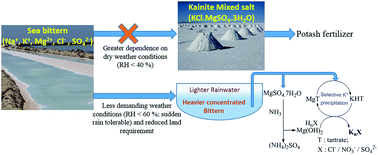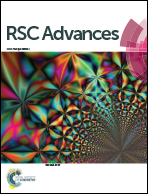Production of pure potassium salts directly from sea bittern employing tartaric acid as a benign and recyclable K+ precipitant†
Abstract
The shortage of land and vulnerability to climate change expose the future production of potash from sea bittern through an evaporite route to greater risks. Potash recovery through selective extraction from bittern is an attractive alternative. Unfortunately, previous attempts in this direction have suffered from one drawback or another. The present study reports a viable scheme employing tartaric acid as a benign and recyclable K+ precipitant. The key steps in the scheme were (i) selective precipitation of potassium bitartrate in 81.2% yield with respect to magnesium tartrate used, (ii) decomposition of the bitartrate salt into potassium nitrate with regeneration of magnesium tartrate, and (iii) recovery of residual tartaric acid from K+-depleted bittern as calcium tartrate, from which tartaric acid was regenerated and reused. The process was made further viable through co-production of Epsom salt (0.30 t/t of KNO3) and ammonium sulphate (1.47 t/t of KNO3). Spent bittern, containing <50 ppm of tartaric acid, was the only effluent. The overall energy requirement for a 1 TPD KNO3 plant was estimated to be ca. 38.31 GJ per t of KNO3 production, along with the associated products, comparing reasonably with the computed figure of 34.80 GJ based on available data from a standard database. A simplified version of the above scheme yields a K–N–S compound fertilizer currently under evaluation.


 Please wait while we load your content...
Please wait while we load your content...